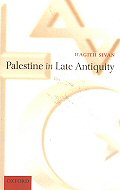|
Palestine in Late Antiquity
|
|
Hagith Sivan
|

|

Hagith Sivan offers an unconventional study of one corner of the Roman Empire in late antiquity. During the period 300-650 CE the fortunes of the 'east' and the 'west' were intimately linked as thousands of westerners in the guise of pilgrims, pious monks, soldiers, and civilians flocked to what became a Christian holy land. This is the era that witnessed the transformation of Jerusalem from a sleepy Roman town built on the ruins of spectacular Herodian Jerusalem into an international centre of Christianity and ultimately into a centre of Islamic worship. It was also a period of unparalleled prosperity for the frontier zones, and a time when communities of Christians, Jews and Samaritans were engaged in fierce competition over a tiny territory termed 'holy'.
How did these groups define themselves in relation to each other? What conflictual and dynamic discourses did they develop to contest, adapt, and adopt ideals and ideologies in order to promote and protect their identities?
Sivan decodes the intricacies of a symbiosis based on the rhetoric of controversy and on violent confrontation. Delineating the formation of new communal boundaries, Palestine in Late Antiquity recaptures and reconceptualizes a crucial period of history between the Christianization and the Islamization of Roman Byzantine Palestine.
|
|
